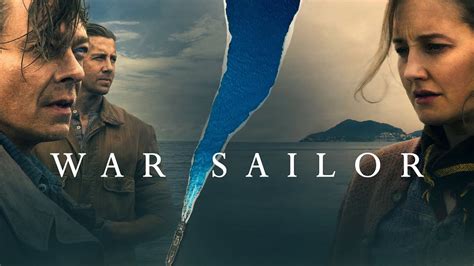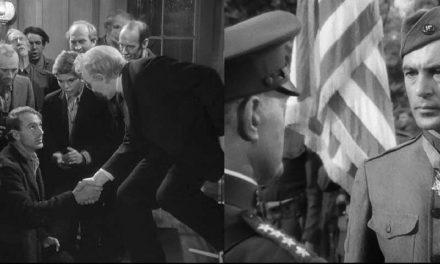War Sailor (Krigsseileren) is a three-part miniseries currently airing on Netflix. It was released as a two-and-one-half hour film in 2022 and submitted by Norway for Best International Film at this year’s Oscars. The miniseries runs about thirty minutes longer, but, since I haven’t seen the shorter version, I can’t say whether the additional footage enhances the story.
Whatever the length, War Sailor is a somber, engrossing drama about Alfred Garnes (Kristoffer Joner), his wife Cecilia (Ine Marie Wilmann), and his best friend Sigbjørn Kvalen (Pål Sverre Hagen). The two men are sailors in the Norwegian merchant marine as war threatens to engulf their country. Inevitable though the beginning of war may appear to us from a distance of eighty-three years, Alfred and Sigbjørn prepare to steam into the Atlantic on an eighteen-month cruise in hope that hostilities may be averted, at least for their country. Promising that he will return, Alfred bids farewell to Cecilia and his three children, including the eldest, a slightly crippled daughter, who takes his departure especially hard.
Once they are in the middle of the ocean, they learn that Norway has entered the war and that the country’s merchant service will join British convoys shuttling supplies from America and back. So, in effect, the crew is pressed into a fight they didn’t choose. And that’s one interesting detail in War Sailor: the men are strangely non-committal about the conflict.
The stage, then, is set for a nerve-wracking, action-packed war at sea. But War Sailor does not deliver, at least in the “action-packed” department; scenes of actual battle are rare and sometimes peripheral. “Never-wracking” it manages somewhat unconventionally by concentrating on the lives of Alfred and Sigbjørn: their longing to return home, the squabbles with other crewmen, the visions, sometimes distant and other times close, of sinking ships, differences with their master, and, after a harrowing passage to New York, the moral dilemma of whether to cast a blind in the direction of those on the ship who desert.
Matters reach a fever pitch on their return trip—or, rather, their attempted return—when the ship is torpedoed, with only Alfred, Sigbjørn, and two others surviving, all four afloat on a detached rectangle of deck, simultaneously a life buoy and a daily reminder of the ship they have lost. Days later, when a rescue ship appears to take them to Halifax, Nova Scotia, the survivors number only two. The youngest of the original four was badly wounded and snatched from the sea. But death is so near that the German officer (from the submarine that sank their ship and stops to give them some supplies but not safe passage) can only shake his head sadly and hand Alfred some tubes of morphine. It isn’t long before the inevitable happens, and they pass the dead man over the side. The fourth survivor is a would-be preacher. Unstable and given to crazed maledictions about the evil he thinks he sees, he tries to murder Alfred and Sigbjørn who, to save their lives, must kill him.
In Halifax, things go badly for Alfred. A fight with another inmate lands him in detention, and, not long after that, he learns his city, Bergen, now a German base, was bombed by the British, with his family presumed dead. When the time comes to embark for Norway, he bids farewell to Sigbjørn who is returning, and remains in Halifax. He then disappears.
Once he’s back home, Sigbjørn finds that Cecelia and the children are alive; they were safe in the country when the raid flattened their apartment building. He stays with them, working in the shipyard as a welder and doing chores around the house. Although he sends inquiries through the merchant marine to discover Alfred’s whereabouts, he hears nothing. As the presumption of death or, at least, the conviction that Alfred will never come home hardens into unspoken certainty, romance grows between Cecelia and Sigbjørn.
No sooner has their happiness—as well as the children’s—blossomed than word arrives that Alfred is alive in Singapore. Dutifully, Sigbjørn pledges to bring him back to his family, which he does. But months later it is Alfred alone that walks haltingly up the path to the house, a withdrawn, emaciated man. It would be a stretch to call the reunion bittersweet; the sweetness is nonexistent. Days pass and he cannot find a job with the service (he’s branded as a troublemaker for the events in Halifax) or restore the broken ties with his family. The action shoots ahead to the 1970s, and although he and his family remain together—as much as college and the children’s marriages will permit—he is a mostly silent presence. When Sigbjørn unexpectedly appears after an absence of years, the two men can barely converse.
As I said earlier, War Sailor is somber, uniformly so, and sometimes a bit slow. Yet it offers a poignant view of the men who didn’t want to fight but, out of necessity, put their lives in jeopardy in the most destructive war of modern times, perhaps of all time. Were they heroes? I’ll leave that to others. But Alfred and Sigbjørn are tragic and maybe in a limited classic sense of the word. The decisions they make, Alfred’s not to return to Bergen, Sigbjørn’s to seek a happiness he might have guessed he could never possess, leave both men’s lives in ruin, but they elevate War Sailor to a level few contemporary war films reach.
Note: I suggest watching the film in Norwegian with subtitles; the dubbed English detracts considerably from its impact.














